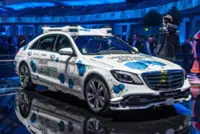Look, no hands! Driver in cars with modern assistance systems can hand over the steering work to software in certain conditions. Photo: dpa
More and more cars can help you stay in lane and warn about something in your blind spot, but a growing number of cars also have an assistant that can drive all by itself – at least in certain conditions.
What the electronic helpers are able to do all depends on their so-called autonomy level.





